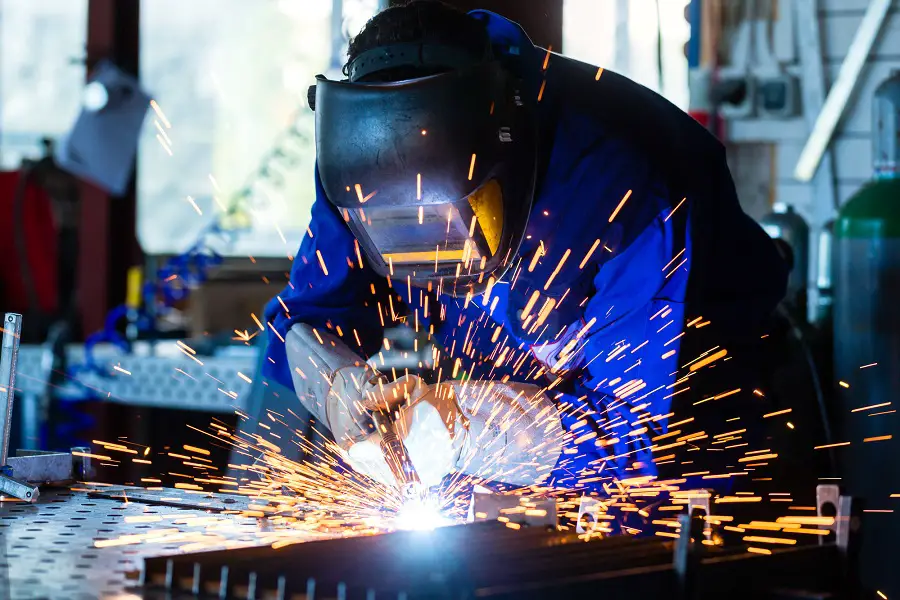There are many reasons why your auto-darkening welding helmet isn’t working properly. Because a welding helmet protects you from heat and flying sparks, you don’t want to simply put up with it. You should also be able to see what you’re doing, and you should be able to work safely and comfortably.
Before you completely replace a malfunctioning welding helmet, check it to determine if this is a problem you can fix yourself. There are many simple solutions that you can easily take care of yourself, like changing one small part. Don’t jump immediately to buying a new helmet until you have eliminated repair options.
Here are a few troubleshooting tips you can try before completely replacing your helmet.
Problem 1: Low Visibility
You can tell that low visibility is the problem if you have trouble seeing when you put the helmet on. You want to be able to see what you’re doing, especially while dealing with hot metal and flying sparks.
There are a few reasons why your welding helmet may be hard to see out of. Fortunately, if low visibility is your problem, it’s relatively easy to fix.
Clean Your Welding Helmet
Welding is a dirty job, and a lot of debris gets kicked up into the air during welding projects. Your helmet may have simply collected a lot of the dust that flies up into the air when you’re working.
To determine whether this is the problem, clean off the lens and see if that improves visibility. If that still doesn’t help, you may need to simply replace the lens.
Adjust the Sensitivity
Another solution for low visibility in your welding helmet is to adjust the light sensitivity settings. The auto-darkening feature on your welding helmet is one of the essential features. It’s in the name: auto-darkening. If this feature starts acting up, it can be annoying and cut down on productivity.
An auto-darkening welding helmet ensures that you don’t have to adjust the darkening feature manually. You have control over how the helmet responds to light, but the helmet’s lens filters the light for you automatically. That way, you can spend more time welding and less time fiddling with settings.
To make sure your sensitivity is appropriately adjusted, do a sun test. If the helmet gets dark very quickly, the sensitivity is the problem. Adjust the settings until you are satisfied with the sensitivity. You might solve this by replacing a battery, but we recommend playing with the sensitivity settings first.
Problem 2: Restricted Visibility
Restricted visibility is different from low visibility. If your visibility is restricted, that means that you can see fine, but your field of vision is too narrow. If this is the case, you may be using the wrong kind of lens.
If you want to see more of your weld at a time, you should replace your current lens with a wider one. This will give you a larger field of vision so that you don’t have to turn your head to see different parts of the weld. This will save you a lot of energy.
Problem 3: Too Much Visibility
You might put on your helmet and feel like the weld is too bright. You might feel like the helmet isn’t filtering the light at all. This can be a concern because you want your helmet to filter out brightness so that you don’t damage your eyes while welding.
Fortunately, this is also a pretty easy fix. Your welding helmet should have come with a variety of shades. Some welders prefer a lighter shade so that they can see what they’re doing better, but that option isn’t for everyone. If you find that the light is too bright for you, use a darker shade.
Problem 3: Flickering Light
You’ve got enough going on during a weld without your vision flickering through the helmet. It’s distracting and concerning and puts a strain on your eyes. When sparks are flying, and you’re working with heated metal, you want to be able to see what you’re doing at all times. Flickering in your field of vision can not only be annoying but may also be dangerous.
A problem with the auto-darkening filter usually causes flickers in your welding helmet. You can’t just adjust the sensitivity for this. The solution is to replace the batteries in your helmet since they are probably running out of juice. Think of it like a flickering light bulb or a radio with spotty reception.
Some welding helmets don’t have replaceable batteries. If this is the case, you will have to buy a new helmet.
Problem 4: Adjustment Time Is Too Slow
If your welding helmet is darkening too slowly in response to light, you are constantly struggling to see every time a change in brightness occurs. This can put a strain on your eyes and makes welding a lot more complicated.
If you notice that your helmet is darkening too slowly, you need to decrease the reaction time on the helmet. Reduced reaction time means that your helmet is quicker to react and to a change in brightness. Your helmet responds quickly to every spark and flame, and so do you.
Keep on Welding
When it comes to troubleshooting a welding helmet malfunction, the solution is usually pretty simple. Whether it be replacing a lens, battery, shade, or just cleaning a bit of dust off the helmet, you can probably make the repair yourself.
Take time to troubleshoot these options before you resort to buying a new welding helmet. Most importantly, if there is a problem with your helmet, don’t just ignore it. Your helmet should keep you safe and comfortable during your welding projects. A properly functioning welding helmet makes for better welding projects and a more satisfying day of work for you.


